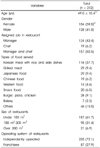1. He FJ, Li J, Macgregor GA. Effect of longer term modest salt reduction on blood pressure: Cochrane systematic review and meta-analysis of randomised trials. BMJ. 2013; 346:f1325.

2. Roger VL, Go AS, Lloyd-Jones DM, Benjamin EJ, Berry JD, Borden WB, et al. Heart disease and stroke statistics--2012 update: a report from the American Heart Association. Circulation. 2012; 125(1):e2–e220.
4. Ministry of Health and Welfare, Korea Centers for Disease Control and Prevention. Korea Health Statistics 2017: Korea National Health and Nutrition Examination Survey (KNHANES VII-2). Sejong: Ministry of Health and Welfare;2018.
5. Mattes RD, Donnelly D. Relative contributions of dietary sodium sources. J Am Coll Nutr. 1991; 10(4):383–393.

6. Kwon YS, Park YH, Choe JS, Yang YK. Investigation of variations in energy, macronutrients and sodium intake based on the places meals are provided: Using the Korea National Health and Nutrition Examination Survey (KNHANES, 1998–2009). Nutr Res Pract. 2014; 8(1):81–93.

7. Ministry of Food and Drug Safety. Only 8% of respondents knows recommended intake of sodium [Internet]. Cheongju: Ministry of Food and Drug Safety;2010. cited 2019 Feb 28. Available from:
http://www.mfds.go.kr/brd/m_99/view.do?seq=13292.
9. Kwon YS, Ju SY. Trends in nutrient intakes and consumption while eating-out among Korean adults based on Korea National Health and Nutrition Examination Survey (1998-2012) data. Nutr Res Pract. 2014; 8(6):670–678.

10. Jung J. Policy trends of sodium reduction. Food Sci Ind. 2016; 49(2):2–7.
11. Shin EK, Lee YK. Comparison of sodium content of workplace and homemade meals through chemical analysis and salinity measurements. Nutr Res Pract. 2014; 8(5):558–563.

12. Jang MR, Hong MS, Choi BC, Han SH, Lee KA, Kim LL, et al. Contents of sodium and potassium for restaurant dishes in Seoul. J Food Hyg Saf. 2015; 30(2):189–195.

13. Lim HS, Ko YS, Shin D, Heo YR, Chung HJ, Char IS, et al. Sodium and potassium content of school meals for elementary and junior high school students in Daegu, Masan, Gwangju, and Jeju. J Korean Soc Food Sci Nutr. 2013; 42(8):1303–1317.

14. Hong SM, Lee JH, Kim HK, Yu R, Seo JH, Huh EJ, et al. Study on sodium reduction: ‘healthy restaurant for sodium reduction’. J Korean Diet Assoc. 2014; 20(3):174–182.

15. Kwon SB, Kim HY. Sensory characteristics of step-by-step sodium reduction on frequently used high sodium foods in the institutional food service industry. Korean J Food Cookery Sci. 2015; 31(4):465–476.

16. Shin HW, Lee YM. The effectiveness of Na reduction program for cook in child-care center-Focus on self-reevaluation and strengthen consciousness-. Korean J Community Nutr. 2014; 19(5):425–435.
17. Kim EK, Kim HY. School dietitian awareness, practice, and sodium reduction plan in school meal service. Korean J Food Cookery Sci. 2016; 32(2):222–232.

18. Lee KS. Use of salimeters and sodium reduction education in school foodservice in the Gyeonggi area. J Korean Diet Assoc. 2013; 19(2):173–181.

19. Ahn SH, Kwon JS, Kim K, Yoon JS, Kang BW, Kim JW, et al. Study on the eating habits and practicability of guidelines for reducing sodium intake according to the stage of change in housewives. Korean J Community Nutr. 2012; 17(6):724–736.

20. Jung EJ, Son SM, Kwon JS. The effect of sodium reduction education program of a public health center on the blood pressure, blood biochemical profile and sodium intake of hypertensive adults. Korean J Community Nutr. 2012; 17(6):752–771.

21. Ahn Y, Kim KW, Kim K, Pyun J, Yeo I, Nam K. Nutrition knowledge, eating attitudes, nutrition behavior, self-efficacy of childcare center service employees by stages of behavioral change in reducing sodium intake. J Nutr Health. 2015; 48(5):429–440.
22. Song DY, Park JE, Shim JE, Lee JE. Trends in the major dish groups and food groups contributing to sodium intake in the Korean National Health and Nutrition Examination Survey 1998-2010. Korean J Nutr. 2013; 46(1):72–85.
23. Jiang L, Shin D, Lee YK. Salinity of representative Korean foods high in sodium from home meals, foodservices, and restaurants. Korean J Community Nutr. 2018; 23(4):333–340.

24. Ha IH, Lyu ES. Awareness, practice, and obstruction of sodium reduction by middle school dietitians in Busan area. Korean J Food Cookery Sci. 2015; 31(2):225–232.

25. Park S, Lee J. ‘When operating a cafeteria, sales come before nutrition’ - finding barriers and facilitators to serving reduced-sodium meals in worksite cafeterias. Public Health Nutr. 2016; 19(8):1506–1516.

26. Ma GX, Shive S, Zhang Y, Aquilante J, Tan Y, Zhao M, et al. Knowledge, perceptions, and behaviors related to salt use among Philadelphia Chinese take-out restaurant owners and chefs. Health Promot Pract. 2014; 15(5):638–645.

27. Jacobson MF, Havas S, McCarter R. Changes in sodium levels in processed and restaurant foods, 2005 to 2011. JAMA Intern Med. 2013; 173(14):1285–1291.










 PDF
PDF ePub
ePub Citation
Citation Print
Print








 XML Download
XML Download